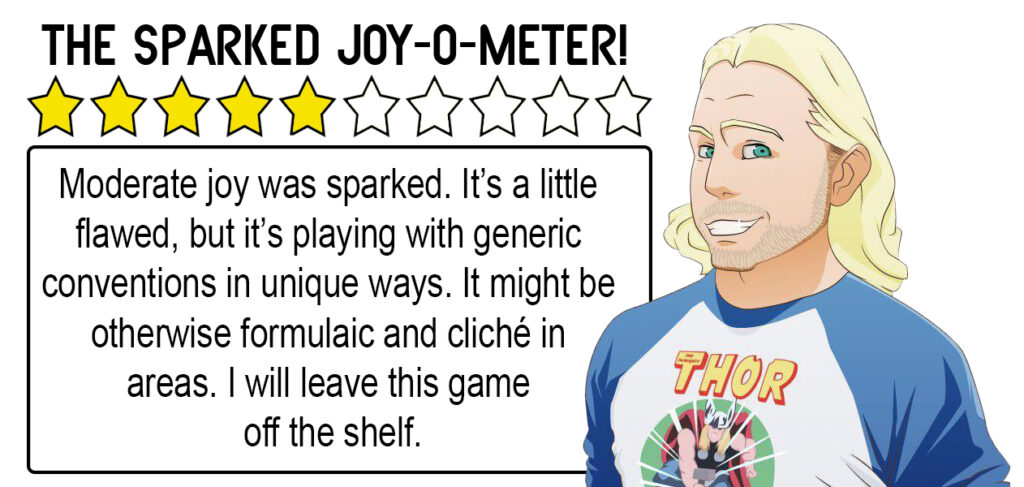Chrono Cross
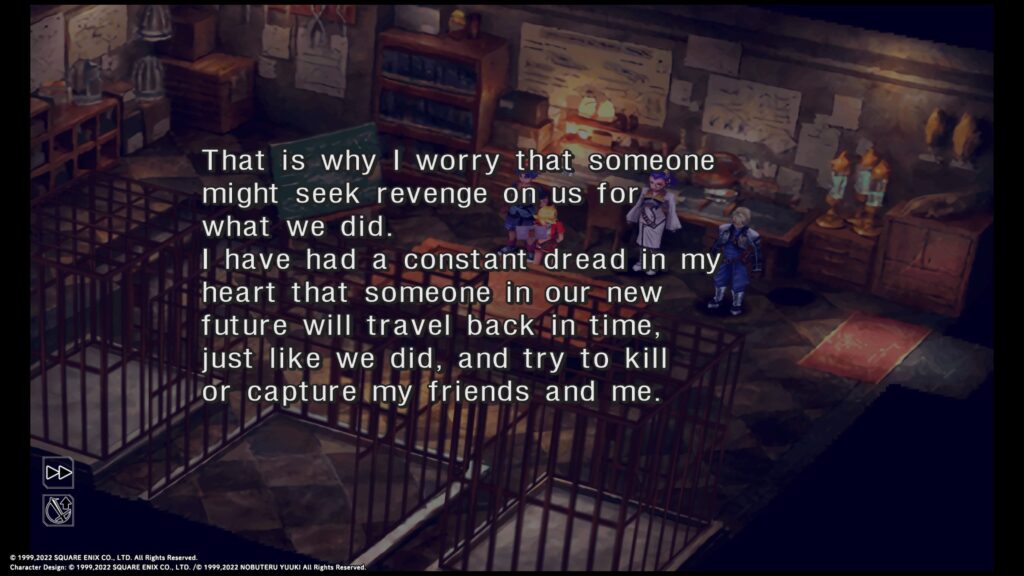
Introduction
Merry Christmas, Happy New Year, happy holidays, and good tidings. Hopefully, you received some nice gifts, made some nice memories, or got to relax. If not, well, I hope there were some nice opportunities to day-drink. Christmas officially started my transition into the next generation of game consoles as I received a PS5. There are still quite a few games I need to finish on my PS4, but it was time to upgrade (although a new computer may be next). Given that I have some great games to play on my new console, it makes complete sense that this entry is on, *checks notes*, Chrono Cross?! It’s New Year’s Eve and you’re already drinking, so crack one open for this retro review.
Chrono Cross (henceforth CC) debuted in 2000 in the US, so perhaps an explanation on this time lapse is in order. Chrono Trigger is one of my favorite SNES games. I waffle between CT and Final Fantasy VI, but I’d probably give the nod to CT overall. However, I never gave CC a chance when it debuted. The combat system didn’t click; the protagonist seemed bland; the story dragged; and I didn’t see any immediate connections to its predecessor. The last point is unfair because, in many ways, CC should be evaluated as its own unique game rather than a continuation of the (defunct) Chrono series. Further, since the game is a part of the late-90’s pantheon of Square RPGs, it’s considered classic despite its polarizing concept. In a way, CC reminds me of a conversation I had with a former colleague about one of Square’s other hit 90’s RPGs, Xenogears. I played the game several times when it was first released and loved it despite its rushed nature. My colleague, however, didn’t play the game and refused to because too much time elapsed. He wished he played it when it first came out, but concluded that playing it several years later would make it seem dated. Such is the case with video game nostalgia as many of us are transported back to familiar times if we played the games, but there is also a sense of FOMO if we weren’t able to play said games when they initially debuted.
This brings me to CC. Over the course of the last few weeks, CT was my go-to 3DS “game before bed,” and it still holds up remarkably well. Not only is CT still a fun and somewhat effortless game, but the latest playthrough featured some plot threads and themes that I missed over the years, which piqued my desire to play CC. Honestly, if this weren’t the time, I’d probably never get around to it. So, I downloaded the Radical Dreamers edition onto my PS4 and gave it a whirl. I often incorporated certain cheats available in this edition (including infinite health and an even faster sprint feature) in large part because I wanted to watch the story unfold, and I didn’t want to invest more time than I needed to. For this nostalgic review, I’ll focus on four elements: the atmosphere (world and music), gameplay, characters, and story. I have friends who love and hate this game, so let’s see where I stand. Plan on drinking when I discuss the story in more detail.
Atmosphere
CC takes place in the El Nido Archipelago 20 or so years after Chrono Trigger’s 1000 AD epoch, although you’re never able to visit any of those locations. It’s actually a very small gameworld, and the gamer will travel between two dimensions: one in which Serge (the protagonist) is alive, and the other in which he died (more on the story later). The overworld map resembles the map system used in CT in that the party will only encounter enemies (who appear on the screen) in specific dungeons/labyrinths. Given that there are so few locations, the gamer will repeatedly end up in places like Termina, Arni Village, and Viper Manor (in both worlds, of course). Despite the lack of locales, it’s a tropical world, beaming with life. This aspect is thanks to Yasunori Mitsuda’s soundtrack, which many gamers consider to be among the best video game scores ever conceived. I’m a music junkie, and there are several songs that stand out. The score works as a whole to reflect the vibe of a laid-back yet somber archipelago. As a result, some songs aren’t exactly “flashy,” but they complement the atmosphere of the game. That said, due to the lack of locations, songs can become repetitive. Also, the main battle track is among the worst I’ve heard in any video game, which might have ultimately impacted how I felt every time I was forced into battle. Speaking of battle tracks, let’s talk about the gameplay.
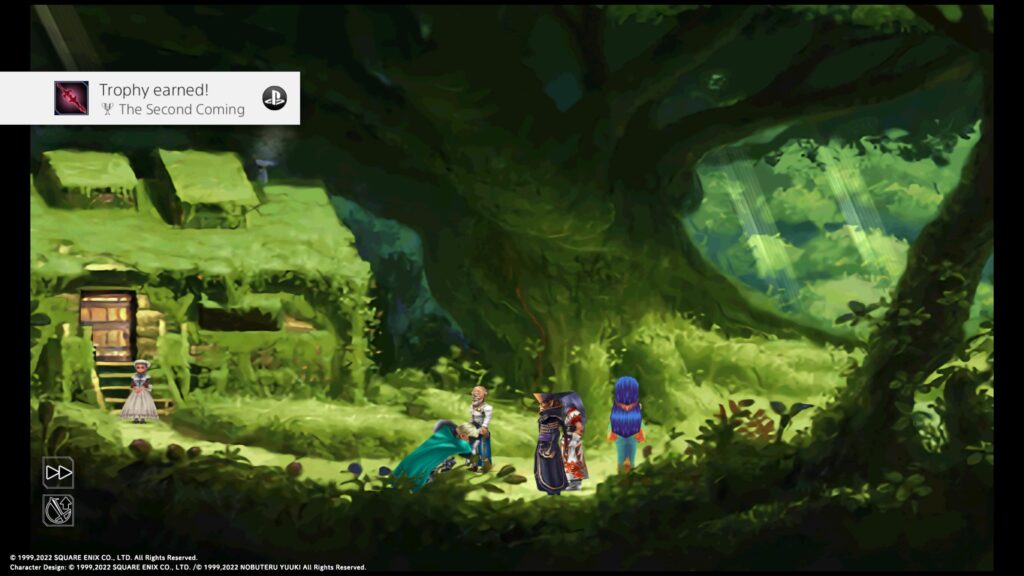
Gameplay: Meh
I mentioned earlier that I activated cheats in the Radical Dreamers edition that 1) increased the speed of the game (dialogue, walking, and sprinting), and 2) ensured any enemy attack wouldn’t land. I tried to play the game straight early on, but it was way too slow for me. Additionally, while I commend CC’s unique approach to its divisive battle system, it wasn’t my thing. There are two basic components at play. The first component is a stamina bar that controls character actions per round. For example, the gamer can unleash three different physical attacks: weak, medium, and heavy. However, each physical attack costs a certain amount of stamina points, and each has an accuracy percentage that determines the likelihood of landing an attack. Suffice it to say, there will be a lot of misses. The second component is the “Elements” system. Since characters don’t have unique spells at their disposal (each has a few specific skills, though), anyone can equip any Element. Each character has an “innate” Element, but I honestly just automatically awarded Elements to my characters to save myself the hassle of menu-diving. Further, unless multiple copies of the same Element are equipped, the character can only cast each spell once. Once it became clear that I was only interested in the game’s story, the activated cheats allowed me to care very little about the Element system. In fact, I usually just launched some heavy physical attacks and waited for them to land. I’m also still on the fence about the game’s leveling up system. After every boss fight, the characters will receive a star that grants a large stat boost. After that initial boost, minor random enemies will provide small boosts until those run out. On the one hand, this approach removes grinding. On the other hand, after a certain point, enemy encounters don’t yield any experience and just become annoying. I mean, imagine running through a dungeon and triggering multiple battles that don’t make the party stronger. It’s certainly an innovative approach, but the battles just aren’t fun as a result. Speaking of innovation, unless enemies drop armor, the gamer must rely on crafting it via blacksmiths. This approach sounds cool in theory, but there aren’t that many weapons or armor options in the game. Ah, well. Chalk that feature up as personal preference, I guess.
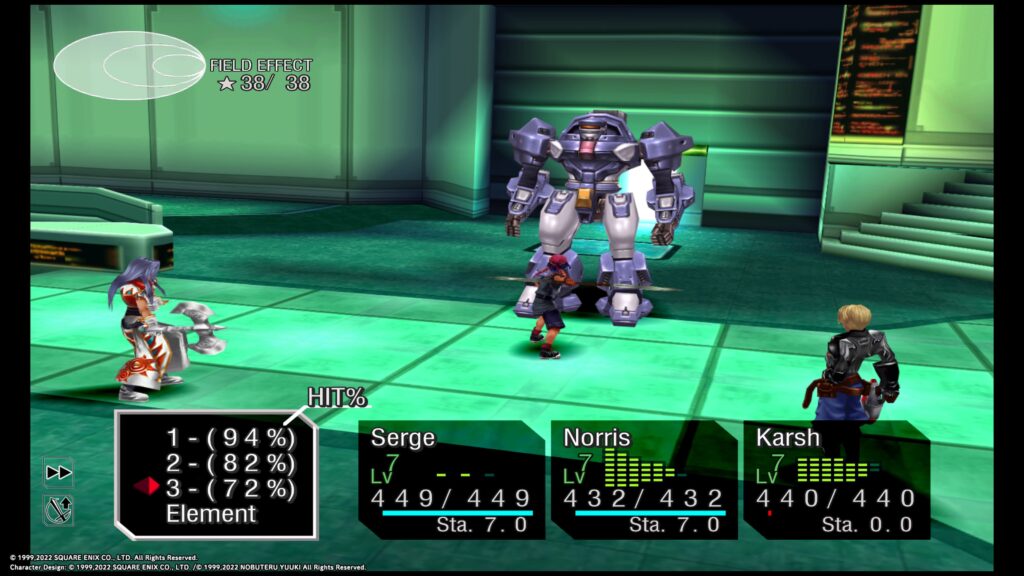
Characters: So, What Exactly Do Y’all Do?
Speaking of blacksmiths, one of my previous favorite JRPG franchises was Suikoden, which is primarily known for its whopping 108 recruitable characters. CC has the second-most recruits I’ve encountered in a JRPG as there are 45 playable characters. However, the problem is that most of them are unnecessary. The same is true for Suikoden, but the series does have a main cast, and many of the ancillary characters have moments in which they develop. During my CC playthrough, a quarter of the cast had moments in which some of their backstories came out. Most of the characters are entirely pointless, including a turnip, a dude who turns into a mushroom, and a sentient voodoo doll. Eventually, I found my interchangeable cast of 4 – 5 recruits that I liked and didn’t test everyone out. From the recruits I did test out, I didn’t notice any earthshattering differences outside of characters like Glenn (apparently). There’s also a space alien who becomes vital to the plot as the party needs to use his spaceship. In any event, those looking for strong character depth won’t find much of it in CC as a handful of recruits (including Serge, the silent protagonist) exist to advance the plot. I’ve saved the story for last, so let’s dive into that next.
Story: That Was Cool, That Was Pointless, That Kind of Sucked, Repeat
Since CC came out 23 years ago, I was primarily interested in the story. As I commented to a few friends while playing CC, it is among the most bizarre JRPGs I’ve encountered. The gamer controls Serge in the sleepy village of Arni. After the first fetch quest, something happens in the space-time continuum that transports Serge to an alternate dimension, one in which he died 15 years earlier. One of the most common refrains I encountered online is that CC is a solid game, but it’s a terrible sequel. In fact, save for some occasional references, gamers who didn’t finish CC may wonder how it bears any connection to its predecessor. In truth, I encountered a whole lot of nothing in the first half (perhaps even two-thirds) of the game as I partook in multiple fetch quests to track down the game’s first primary antagonist Lynx, a feline demi-being who desires the Frozen Flame. This quest produces the first major plot twist. In the Chrono Universe, a “Chrono Trigger” is a being who can travel between dimensions and alter time. Crono in the original was one such being. Serge is another. Lynx swaps bodies with Serge in order to absorb that power/ability/gene/whatever. For a good chunk of the game, the gamer controls Serge who is in Lynx’s old body. They lose access to the characters they met up to this point (they return at the end), and the gamer must recruit new characters and visit previous locations in a new body to track down Lynx who is now Serge. Wild, right? It gets weirder. The game’s tone and focus both shift as the party gains access to a location on the world map called the Dead Sea, which houses the remnants of a technologically advanced laboratory. While there, Serge meets a friend of his father who sailed with him to look for help after Serge was bitten by a werepanther. Weirdly, I think that was the plot of a True Blood episode, but I digress. Moving on. Honestly, I’m still not totally sure what happened, so you can look elsewhere for a synopsis of these events.
The story, while interesting, is a hot mess at times. Nevertheless, the events at the Dead Sea trigger (har har) the primary plot of the game. At this point, it felt like Square’s team played games like Xenogears and Breath of Fire III because I began to see traces of those stories as well. While Xenogears was also a hot mess at times, it emphasized themes like fate, the past, and humanity’s true purpose, the latter being that mankind exists solely to become one with Deus as it gradually recovers over 10,000 years. In the case of Breath of Fire, Serge and his allies must eventually do battle with six elemental dragons to gain their blessings in order to enter the labyrinth called Chronopolis. While in this research lab, Serge and the gang once again do battle with Lynx-turned-Serge, who reveals that not only was Lynx Serge’s father, Wazuki, but also a supercomputer called FATE.
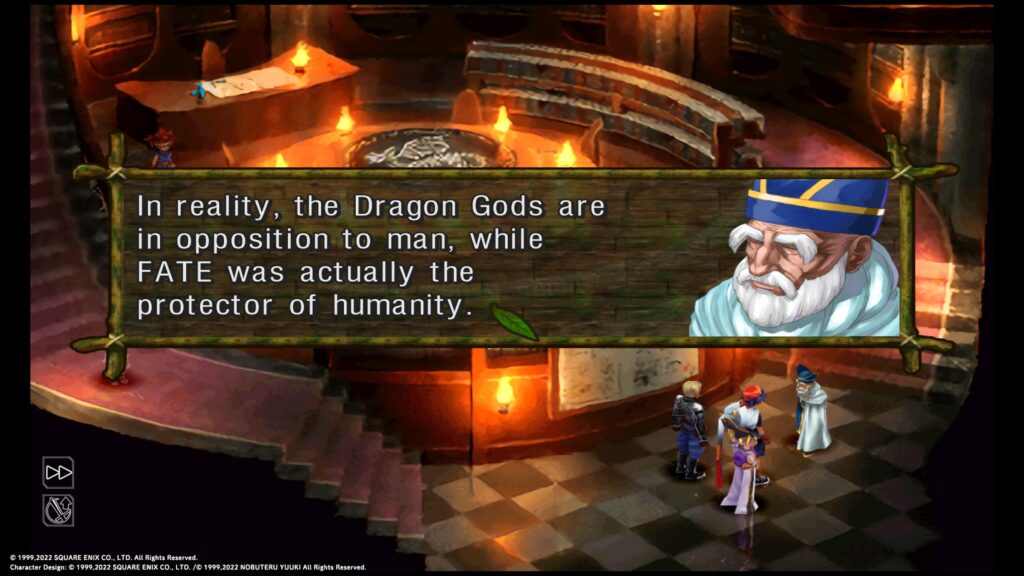
I’m actually having trouble wrapping my brain around the story while I write, so I’ll just focus on the second major twist. Remember those dragons who lent Serge their strength? Well, it turns out they weren’t so magnanimous after all. In fact, they were hoping that Serge would defeat FATE so that they could finally destroy humanity. To understand some of the story elements here, we must go back to the 65,000,000 BC epoch in Chrono Trigger. During that era, Lavos burrowed itself into the planet and inadvertently wiped out the Reptites. If the second twist in the game is that the dragons fuse to become the penultimate boss, the third twist is that Lavos allowed primitive humans to thrive by eradicating the superior Reptites. In other words, the extraterrestrial parasite that destroyed the planet in the previous game actually enabled humans to adapt (and develop magical powers) to a world that was more conducive to the Reptites. What’s wild about this revelation is that while the planet seemed to help Crono and his party in CT (the planet itself might have helped create the time gates), there are indications that the planet despises humans in CC. This eventually leads to the game’s final twist, which is that Schala from the first game was whisked away to another dimension as the Ocean Palace became the Black Omen, and she fused with Lavos. If the game weren’t nuts enough already, before Schala was consumed by hatred and became the Dream Devourer, she helped Serge twice to set the game in motion. First, she hears his cries after the werepanther attack, which produced the storm that allowed him to interact with the Frozen Flame. Second, she cloned herself and sent the baby (Kid) to Lucca’s orphanage. As it turns out, the game’s protagonist might not even be Serge at all, but rather Kid. The Guru of Time, Belthasar, initiated Project Kid in the future to save Schala. In order to do that, Serge and his team partake in one final battle using the Chrono Cross, which is basically a magical synthesizer. The correct sequence of Elements will produce a melody that unlocks the true ending.
Still with me? Hell, I’m not. In fact, I’m not even sure if I correctly summarized all of that! However, these connections to CT were interesting. My problem with them is that these important nuggets come out during info dumps at the very end of the game. In truth, there is a whole lot of nothing throughout the game in large part due to the game’s pace and a ton of backtracking to previous locations in both dimensions. Had these twists and info dumps occurred periodically throughout the game rather than all at once at the end, the story may have been tighter overall. From what I gathered during this playthrough, to fully appreciate CC means to complete it in its entirety. It’s a long walk, though, and gamers can’t be faulted if they aren’t or were never able to get into CT’s sequel.
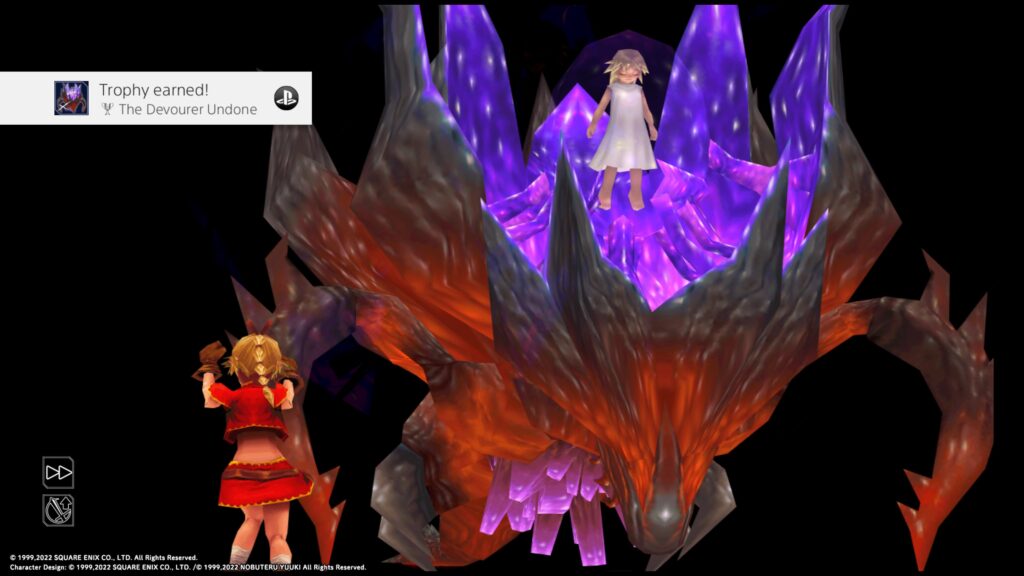
Final Thoughts
Phew. Thanks for making it this far. CC is a solid game overall despite its flaws. I think it’s also important to keep in mind that it tried to do away with several RPG conventions in order to breathe life into the genre. It’s bizarre and often hard to comprehend, but it’s an original experience that belongs in the pantheon of other unique RPGs from this era, including Xenogears and Parasite Eve. That said, like Xenogears, CC is a hot mess at times. Both are ambitious projects that are sometimes hard to follow and whose mechanics, while innovative, are polarizing. What’s also interesting about CC is that it somehow both closes the Chrono series and leaves it open as it is suggested that in this timeline, most of the original characters are dead. For example, characters mention Lucca throughout the game, but the game heavily implies she was killed at some point. Further, at the end of the DS version of CT, a cutscene suggests that some sort of time villain overthrew Guardia and killed Crono. Perhaps some of these loose ends would have been answered if Chrono Break weren’t cancelled years ago. Then again, maybe the series was going to take a dark turn regardless of CC‘s plot. Dark turn or not, since I got my answers after playing CC, I lost interest in CT. I tried starting a New Game+ of CT right after CC, but just couldn’t find the drive to keep going (given my backlog, this was the right move). Whatever the case, CC actually does serve as a direct sequel to CT. It deserves praise for its experimentation, and I am glad I beat it just so I can say I played a classic RPG from the early-00’s. That said, if I may be completely honest, I wasn’t blown away by the game, nor do I feel I missed out on anything by not playing it when it came out. It was fun and answered some of my questions, but I don’t envision ever returning to this one.
